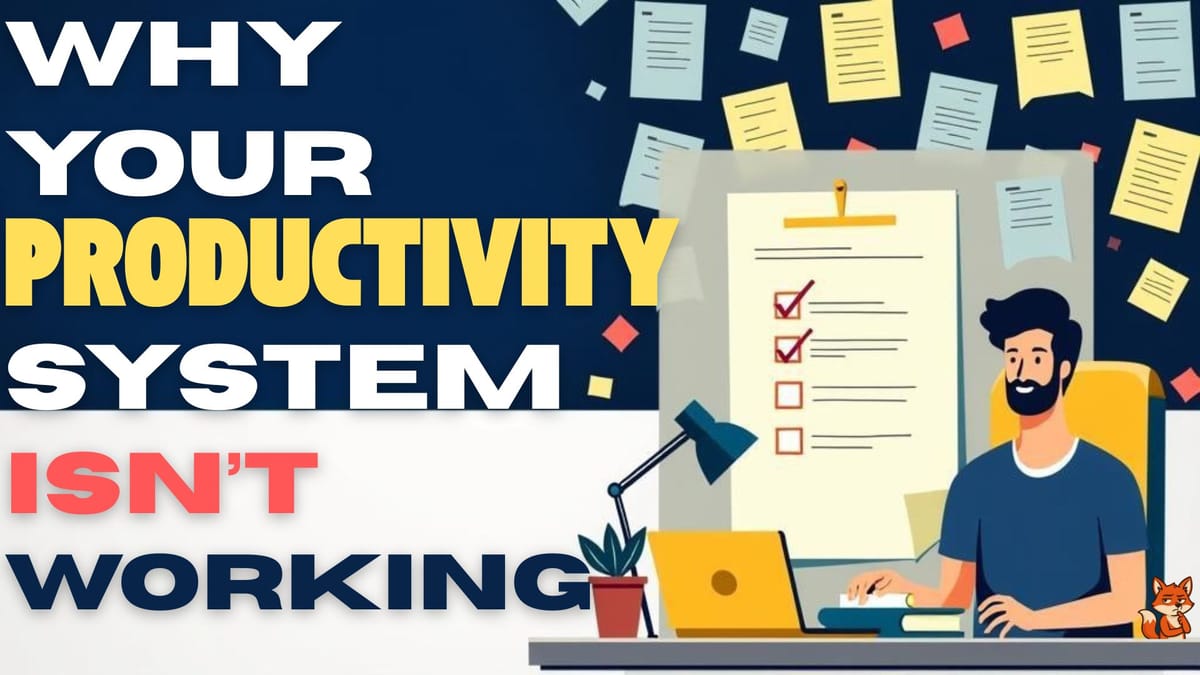Productivity Systems: For People Who've Tried Everything and Still Feel Behind
Build a productivity system that actually sticks. No complex frameworks that require PhD-level maintenance. Just simple, sustainable systems for getting things done without losing your mind.

Let me paint a familiar picture: You've tried Getting Things Done, bullet journaling, time-blocking, the Pomodoro technique, and about seventeen different apps. For about two weeks, each system felt like THE answer. Then life got busy, you fell behind on maintenance, and now you're back to sticky notes and panic.
Sound about right?
Here's the thing nobody tells you about productivity systems: Most of them fail because they're designed for an imaginary person who has perfect conditions and unlimited energy for system maintenance.
What you actually need: A system that works when you're tired, stressed, overwhelmed, and definitely not operating at peak human performance.
The best productivity system is the one you'll actually use when everything else in your life is falling apart. If it only works when you're at your best, it's not a system - it's a fair-weather friend.
Why Most Productivity Systems Fail
The fantasy: You'll diligently maintain a complex system every day, process your inbox regularly, and always know exactly what to work on next.
The reality: You'll use it when things are calm, abandon it when life gets chaotic (exactly when you need it most), then feel guilty about "failing" at productivity.
The truth: It's not you. It's the system.
Good systems are designed for real humans with inconsistent energy, unpredictable schedules, and the occasional existential crisis about whether anything matters anyway.
🏗️ Building Blocks of Sustainable Systems
The SIMPLE Framework
S - Stupid Simple
If you can't explain your system to someone in under 2 minutes, it's too complex.
I - Immediately Actionable
You should be able to figure out what to do next in under 30 seconds.
M - Maintainable When Overwhelmed
It works even when you're scattered, tired, or stressed.
P - Personally Aligned
It fits how your brain actually works, not how you think it should work.
L - Low Maintenance
Upkeep should take less time than the system saves you.
E - Easily Recoverable
When you fall off the wagon (and you will), getting back on takes minutes, not hours.
🎯 Core Components Every System Needs
1. Capture System (The Brain Dump)
Purpose: Get everything out of your head into a trusted system
Simple version:
- One inbox for everything (digital note-taking app, notebook, whatever)
- Capture thoughts immediately, sort them later
- Review and process weekly, not daily
Tools that work:
- Apple Notes/Google Keep: Always in your pocket
- Notion: One place for everything
- Physical notebook: When digital feels overwhelming
Rules:
- No editing while capturing (just get it out)
- Process later, not immediately
- Trust the system so your brain can let go
2. Priority Filter (The "What Actually Matters" System)
Purpose: Figure out what to focus on when everything feels important
The Three Lists Method:
- Must Do Today (max 3 things)
- Should Do This Week (5-7 things)
- Eventually/Maybe (everything else)
Weekly review questions:
- What will actually cause problems if I don't do it?
- What will move my important goals forward?
- What can wait without the world ending?
Emergency triage:
When overwhelmed, ask: "If I could only do one thing today, what would it be?"
3. Action Management (The "How to Actually Do Things" System)
Purpose: Bridge the gap between knowing what to do and actually doing it
Time-boxing basics:
- Assign rough time estimates to tasks
- Match tasks to available time slots
- Buffer time between everything (stuff always takes longer)
Energy matching:
- High-energy tasks during peak hours
- Admin tasks during low-energy times
- Creative work when your brain is fresh
Context batching:
- Group similar tasks together
- Do all calls in one block
- Handle emails at set times
4. Review Rhythm (The "Stay on Track" System)
Purpose: Keep your system working without obsessive maintenance
Daily (2 minutes):
- Look at today's priorities
- Adjust based on energy/reality
- Capture anything new that came up
Weekly (15 minutes):
- Review what got done vs. what didn't
- Plan next week's priorities
- Clear out completed items
Monthly (30 minutes):
- Assess what's working in your system
- Adjust processes that aren't helping
- Archive old projects
🛠️ Popular Systems, Simplified
Getting Things Done (GTD) - The Starter Version
Original: Complex five-stage workflow with multiple lists and weekly reviews
Simplified:
- Inbox for everything
- Weekly sort into Do/Delegate/Defer/Delete
- Next actions list organized by context
Best for: People who like structured processes but want less complexity
Bullet Journal - The Digital Version
Original: Handwritten rapid logging system with symbols and migrations
Simplified:
- Daily task list with simple bullets
- Monthly review of goals
- Future log for upcoming events
Best for: People who like the bullet journal concept but want digital convenience
Time Blocking - The Flexible Version
Original: Schedule every minute of every day
Simplified:
- Block time for important work only
- Leave buffer time between blocks
- Protect focus time but allow flexibility elsewhere
Best for: People who need structure but hate rigid schedules
The Eisenhower Matrix - The Practical Version
Original: Categorize everything by urgent/important quadrants
Simplified:
- Important + Urgent = Do now
- Important + Not Urgent = Schedule
- Not Important = Delegate or delete
- Review weekly to prevent everything from becoming urgent
Best for: People who struggle with prioritization
🎨 Designing Your Personal System
Step 1: Audit Your Current Chaos
Track for one week:
- How do you currently capture tasks/ideas?
- When do you feel most/least productive?
- What derails your productivity most often?
- What time of day do you naturally review and plan?
Step 2: Pick Your Core Tools
Choose ONE tool for each:
- Capturing inputs
- Managing tasks
- Scheduling time
- Taking notes
Avoid platform proliferation. More tools = more places for things to get lost.
Step 3: Design Your Minimal Viable Process
Start with:
- How you'll capture new things
- When you'll review your lists
- How you'll decide what to work on each day
Add complexity only after the basics are working smoothly.
Step 4: Test and Adjust
Try your system for 2-3 weeks, then evaluate:
- What's working well?
- What feels like unnecessary friction?
- What are you avoiding or skipping?
- Where do things fall through the cracks?
Adjust one thing at a time. System evolution beats system revolution.
🎯 Systems for Different Life Situations
For Students
Core needs: Juggling multiple classes, projects, deadlines
Simple system:
- One calendar for all deadlines and commitments
- Weekly planning session to break down big projects
- Daily priority list based on what's due soon + what needs long-term progress
Key tool: Something that syncs across devices (Google Calendar + simple task app)
For Parents
Core needs: Constant interruptions, unpredictable schedule, family coordination
Simple system:
- Family calendar that everyone can see
- "Today's essentials" list that can be done in small chunks
- Quick capture method for when kids are demanding attention
Key tool: Something accessible from phone with voice input option
For Creative Professionals
Core needs: Balancing creative work with business tasks, irregular inspiration
Simple system:
- Separate spaces for creative ideas vs. business tasks
- Time blocks for different types of work
- Regular review to ensure business tasks don't crowd out creativity
Key tool: Visual organization (Notion, Trello, or even physical boards)
For People with ADHD/Executive Function Challenges
Core needs: External structure, visual reminders, dopamine-friendly systems
Simple system:
- Visual task boards with clear progress indicators
- Timer-based work sessions
- Celebration built in for task completion
Key tool: Something with notifications, visual progress, and gamification elements
🚫 System Mistakes That Kill Productivity
Over-engineering: Complex systems fail when life gets complicated
All-or-nothing thinking: Missing a day doesn't mean starting over
Tool obsession: Switching tools constantly instead of improving processes
Perfectionism: Waiting for the perfect system instead of using a good enough one
Maintenance guilt: Feeling bad about not maintaining your system perfectly
Comparison trap: Using someone else's system instead of designing your own
Your System Building Action Plan
Week 1: Foundation
- Pick ONE capture tool and use it for everything
- Set up a basic daily priority list (max 3 important things)
- Establish one regular review time (weekly minimum)
Week 2: Refinement
- Notice what's working and what feels clunky
- Add ONE process improvement
- Resist the urge to overhaul everything
Week 3: Integration
- Connect your system to your calendar
- Practice using your system during a busy/stressful period
- Adjust based on real-world testing
Week 4: Optimization
- Streamline any processes that feel too complex
- Set up backup plans for when you fall off track
- Celebrate that you've built something sustainable
The Bottom Line
The best productivity system is the one that makes your life easier, not harder. It should reduce mental overhead, not add to it. It should work with your natural patterns, not force you to become someone else.
Your system doesn't need to be Instagram-worthy. It needs to be functional when you're tired, sustainable when you're busy, and recoverable when you fall behind.
Start simple. You can always add complexity later, but it's much harder to simplify an overcomplicated system.
Design for your worst days, not your best days. If your system only works when you're operating at peak performance, it will fail exactly when you need it most.
Most importantly, remember that productivity systems are tools, not moral judgments. A good system serves you; you don't serve the system.
Need help designing a system that fits your specific situation? Get in touch to talk through what's not working in your current approach - sometimes an outside perspective helps identify what you actually need vs. what you think you should want.
Ready to optimize your new system? Check out our automation starter pack to reduce manual maintenance, or explore focus tools for scattered brains to make the most of your organized priorities.


